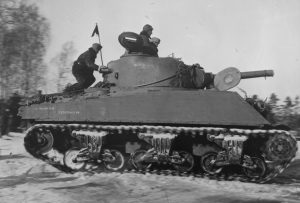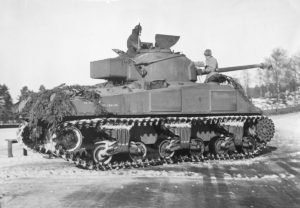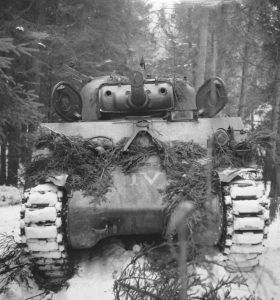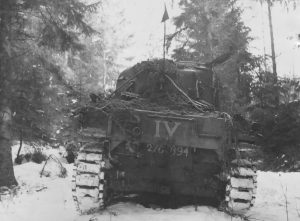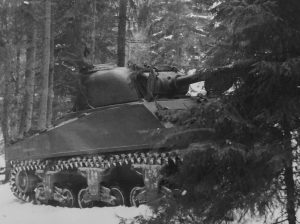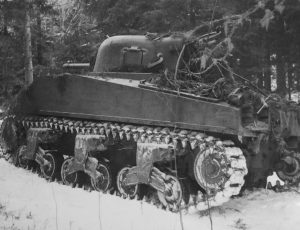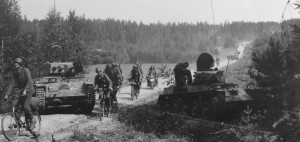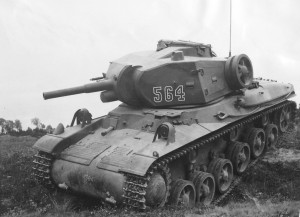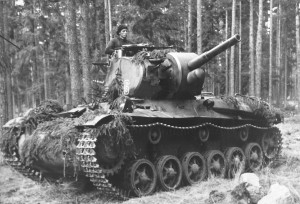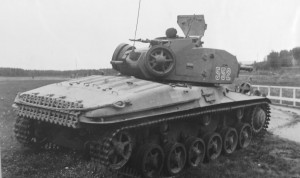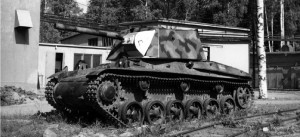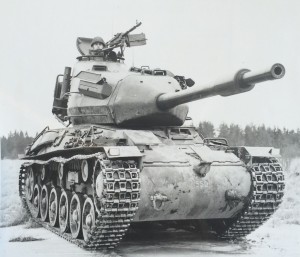Posts Tagged: english
Swedish impressions of the Sherman, part 2
Another report on the Swedish experiences with the Sherman. This is an earlier one, from 1947, and only covers the M4A2 and M4A4. It’s a lot terser than the first one, probably since was an internal report written for the 1946 armor committee by one of its members. The armor committees of the 1940’s were joint groups made up by people from both the Ordnance Administration and various army formations, including the armor school, tasked to figure out where armor technology was going and recommend appropriate responses to the higher-ups.
Without further ado, here’s the translation.
Supplement #1 to minutes of meeting held with the 1946 armor committee on June 16, 1947
Memorandum regarding experiences with tanks of type Sherman, M4A2 and M4A4
Steering gear
The differential steering offers very good performance on roads and on hard ground in terrain. On soft ground the downsides become apparent – the “differential effect” of the steering (translator’s note: it is not clear exactly what this refers to). There is no neutral steering nor any possibility to do a clutch-brake turn, which has turned out to be a noticeable downside since the turning radius is large. The steering levers are close to each other, so the driving position is comfortable.
(Translator’s note: The strv m/42 used a single radius geared steering system; pulling one steering level geared that track down by 2/3rds which produced a fixed turn radius of about 9 meters. However, you could also press a button on the steering level which clutched and braked the inner track completely and let you turn around a point about half a meter from the inner track.)
The steering gear has effective cooling and lubrication, and additionally the brake discs (TN: unsure about terminology here, the Swedish word used is literally “brake belts”) operate submerged in oil, so there is rarely any reason for adjustment. During a road march of about 150 km, the steering gear casing did become very hot to the touch, but the oil temperature never showed more than 110° F, while the maximum allowed is 160° F. There was no noticeable degradation of the performance of the steering gear; it was the same at the end of the march as it was at the start.
There is no parking handbrake nor any brake pedal, but the steering levers can be locked in the rear position. Hereby the extra devices needed for a dedicated braking system can be avoided.
Transmission
Easy to switch gears, effective synchronisation. Can be said to be on par with the transmission in the pvkv m/43. There is no overdrive. Separate oil coolers for the transmission and the steering gear.
Track assembly
Durable and effective, but vulnerable because the road wheels are mounted in pairs. The tanks move smoother and have a more even ride in terrain than Swedish tanks do. When driving on wet surfaces or in upslopes in terrain, the track with rubber pads shows tendencies to slip, which makes the steering not fully effective. Terrain driving performance and obstacle passing is otherwise about the same for the tank with the rubber padded track as it is for the tank with the steel track.
The steel tracks are heavy and make a considerable amount of clattering noise. They are likely to be more vulnerable than “skeleton tracks” (TN: it seems likely that by “skeleton tracks” the author is referring to track links with some sort of hole or gap in the link rather than ones that are completely solid). The arrangement of the guide horns in two rows on the outer sides of the road wheels is fit for its purpose, especially when driving in terrain. The design of the track links – whole links without holes – makes gravel and mud amass in the tracks when driving in difficult terrain and on loose soil.
Turret
The cast design causes certain unpleasant vibrations in the turret when driving. Since the tanks are tall, lurches and other movements are more noticeable than in Swedish tanks. These factors make the personnel show a certain reluctance to stand in the turret while driving in terrain.
Manual traverse is easy to handle because of the powerful gear ratio – 1/4 turn in 28 seconds (strv m/42 23 seconds). Power traverse by wheel turning (TN: no idea what is intended here, literal translation again) – 1/4 turn in 6 seconds, full rotation in 26 seconds. Power traverse with the control set at full power – 1/4 turn 4 seconds, full rotation 19 seconds (strv m/42 1/4 turn 7,5 seconds, full rotation 24 seconds).
The tank commander can power traverse the turret at full speed from his position in the cupola. The turret traverse braking is very effective – as soon as the traverse wheel stops turning, the turret also stops immediately. When power traversing, the turret automatically returns to the position it had when the wheel stopped turning. On the M4A2, the handle on the traverse wheel has a latch, which is pressed when traversing. When this latch is released, the turret is braked.
The turret design with a turret basket that the crew sits in is clearly superior to the strv m/42 (TN: which didn’t have one). The walls of the turret basket are made of perforated sheet metal, so you can see through them.
The gyroscopic stabilization affects the weapons and the telescopic sights, and seems to be effective and rugged.
The weapons are loaded from the left side of the gun – that is, with the right hand. Why is it not done like this in our tanks? It seems appropriate for the heavy rounds in question here.
The observation cupola is used as a ring mount for a 13 mm anti-aircraft machine gun.
Instrumentation
There is a tachometer, which is very important on these tanks since they don’t have a speed governor. The drivers quickly learn to switch gears based on the tachometer readings.
All instruments are electrically signalled, even the oil pressure. Signal lamps are used to a large extent, for example to indicate that the engine has the proper working temperature. The same gauge is in several cases used for different purposes, for example indication of oil and fuel amounts in various tanks – a switch is used to control which device is measured.
Automatic fuses are used consistently in the electrical systems. They are placed easily visible on the instrument panel.
Internal equipment
There’s plenty of room for ammunition – 96 7,5 cm rounds, 300 13 mm, 6750 7,65 mm – and for equipment. The connection plugs for the microtelephones (TN: intercom microphones or entire headsets?) are worth copying. On the M4A4, the commander can stop the engine from his position.
At the rear of the tank, there’s a box with connectors for external telephone lines to the tank commander as well as for connecting an extension cord. There’s also a call buzzer button that alerts the tank commander here.
There’s a separate auxiliary generator motor that charges the batteries and powers the turret traverse and radio while the main engine isn’t running.
There is a fan in the turret for venting smoke and fumes.
The swivel connector seems very effective and reliable.
The seats are practically designed with a spring loaded mounting, which makes adjusting the seat height easy.
The periscopes are made in two parts, so only the top part needs to be replaced in case of a hit or other damage.
The antenna isolators are simple and robust, and are made entirely out of rubber.
In the engine compartment on the M4A2 there is a starter button for each engine, which is very useful during checkups or maintenance work.
External equipment
Stowage boxes for the crew’s personal equipment as well as for the tank’s equipment are mounted on the outside of the vehicle.
The refilling points for fuel, oil and water are clearly marked with text, covered by sturdy hatches and surrounded by a ring of armor. Large and sturdy design.
Service, etc
A large number of informative signs as well as the well illustrated manuals ease the service and maintenance of the tanks. The electrical system is practically designed and easily comprehensible, with cables gathered into a small number of runs that are connected in switch boxes. Plug-type connectors are provided for the devices that are intended to be removable, such as the engine.
On the M4A2, removing and replacing the engine takes roughly the same time as on the pvkv m/43. On the M4A4, only about half this time is required, since most devices remain attached to the engine when it is lifted out of the tank.
The general impression of the tank is good. It is easy to drive, practically designed and durable. There have been no problems with training conscripts on the tank and its various systems. Few repairs have been necessary.
Hans Malmgren
Major
Swedish impressions of the Sherman
In 1946 and 1947, the Swedish army purchased a total of four surplus Shermans (first one M4A2 and one M4A4 without weapons, then a Firefly with the Continental radial engine and one M4 with the 10,5 cm howitzer) from the Brits, mainly to gain experience with foreign tank designs. A few attempts were made to purchase another 50 as surplus (they were very cheap, less than a thousand pounds each – you could get something like 50 modern, fully functional Shermans for the price of a single new build strv m/42), but this deal fell through because of difficulties with finding enough spare parts.
A number of automotive trials were done with these Shermans under field-like conditions, and a few reports were written. One of them – from a winter exercise in 1948 – follows, translated in its entirety. If you’d rather read the original Swedish, here it is in PDF format.
Archive reference: SE/KrA/0363/005:H/F I/3
Cover letter
To the Inspector of the armored troops.
Hereby the undersigned, whom pursuant to Ainsp/C no 23:8 of February 14 1948 was ordered to act as platoon leader of the Sherman platoon, respectfully remits a copy of “Memorandum with certain observations regarding the Sherman tanks in Swedish conditions during the field exercises of February 25 – March 4 1948”, which has previously been submitted to the Vehicle Bureau at the Royal Army Administration’s Ordnance Division.
Skövde, March 12 1948
Sten Korch
Captain
Memorandum
with certain observations regarding the Sherman tanks in Swedish conditions during the field exercises of February 25 – March 4 1948.
The Sherman platoon, which participated in the field exercises pursuant to order Ainsp/C no. 23:8 of February 14 1948, consisted of one Sherman II (airplane engine), one Sherman III (diesel engine) and one Sherman V (Chrysler engines) as well as one terrängpersonbil and one KP-bil, and belonged to the 2nd tank company. At the beginning of the field exercises, the platoon was attached to 11th bicycle rifle co., IIIrd armor infantry bn. I 16, which advanced along the road Granvik – Olshammar – Askersund. The platoon remained attached to this unit until the end of the exercises.
The road along which the platoon advanced was very bendy and hilly, and the road surface was mostly covered by hard ice. In several places the road was so narrow that passing or meeting other vehicles could only be accomplished with great difficulty. During the exercises large parts of the road were mined, and therefore mine hunting had to be done before the tanks could advance. Since the terrain did not permit off-road movement to pass the mined sections, the unit advanced slowly.
After the exercises had ended, the platoon drove to Skövde along the route Askersund – Olshammar – Karlsborg – Tibro – Värsås – Skövde.
Steering
The Cletrac steering has proven to be reliable and effective. The steering problems that have been observed on slippery roads is only caused by the track design (lack of spikes). There have been no issues whatsoever with the steering gears and no reparations or adjustments have been made, despite the drivers only having about an hour of training on these tanks before the field exercises started – they were thus rather unused to the tanks.
(Translator’s note: the fact that the author points out that no adjustments to the steering gears have been necessary as if this was a remarkable fact is because the problems the strv m/42 had with those – its steering gears wore out quickly and had to be adjusted frequently, especially when driven by inexperienced drivers.)
Track assembly
The track assembly has stood up well to all stresses it has been subjected to. It has not been necessary to replace any road wheels or track links. However, the wedges that lock the track pins in place have shown a tendency to loosen and fall off, which is caused by the nuts eventually screwing themselves loose. Even when such wedges have fallen off, neither the track pins nor the guide horns have shown any tendency to move. If a split washer was added under the nut and the nut then tightened hard, the wedge remained where it should.
On icy and slippery surfaces the tracks on the Sherman V, which have U-shaped gripping surfaces, have shown to be unsuitable. On many occasions the Sherman V therefore happened to slip off the road, and on three such occasions one of the tracks was thrown. In one case, the tank could be driven directly back on to the track, but in the other two the track had to be removed completely and placed in front of the tank, which was then driven back on top of it. This repair required about two hours each time. The Sherman V also had problems climbing many steep slopes because of the tracks slipping. By using extra track links (TN: possibly for a different tank? the document is quite unclear here and has a few hard-to-read handwritten corrections), these slopes could be climbed, but this took considerable amounts of time. These extra track links, in sets of 3-5, were placed under the tracks with the guide horns facing down, and this provided extra grip.
Since the Sherman V always was at the head of the column and showed poor performance on an icy road, the onlookers probably got the impression that the Shermans are hard to handle in winter. This is not the case, since the other two tanks never got stuck even once. When driving in terrain, all tanks passed the obstacles they had to pass.
During the drive from Askersund to Skövde on March 2nd (TN: after the end of the exercises), the Sherman V happened to skid off the road in a curve and at low speed drove into a cliff face with the left drive sprocket. The sprocket wheel was crushed and had to be replaced with one from the Sherman that was not participating in the exercises. After the repairs, the tank continued towards Skövde. About 1 km west of Mölltorp, the tank again skid off the road when going downhill, and threw one of its tracks. After pulling the tank back onto the road and re-mounting the track, the tank continued to Skövde without difficulties, since the road after that point was ice-free.
The Sherman III with rubber tracks (TN: surely he means rubber padded tracks?) has proven to perform the best on slippery surfaces and was the easiest to maneuver. To some extent, this is likely because it is the lightest (28 tons).
Transmission and power transfer
The transmissions has proven to be reliable and only one adjustment has been necessary. When the Sherman V collided with the cliff face, the fastening for one of the three clutch arms in the engine clutch was cracked. This was not discovered until the clutch started slipping in a slope after driving about 5 km. After adjustment, the tank could continue with no difficulties and without any noticeable slipping.
Engines
The engines have functioned impeccably and no repairs or adjustments have been necessary. There have been no problems at all with starting, despite the night time temperatures usually being around -15° C (TN: 5° F). No engine heaters were used and running the engines to warm them up was only done during the rest period on the 28th and 29th, when the engines were run at 10 hour intervals. All engines started on the first try, and on the Sherman V it was not even necessary to use the primer. This is remarkable, since the tanks are not intended or equipped for winter use, other than “blinds” (TN: or shrouds) having been mounted to the radiators.
Fuel consumption
The fuel consumption has been low, especially during pure road movements. During the entire field exercise, refueling was only done three times, and usually only one of the fuel tanks needed to be refilled. Altogether during the exercises, a distance of 215 miles or 350 km was covered.
Total fuel consumption during the exercises:
Sherman II: 1090 l
Sherman III: 680 l
Sherman V: 925 l
The high consumption on Sherman II was because the tank being driven about 30 km longer than the others and because it was used for towing on several occasions.
The drive Askersund – Skövde (104 km) resulted in the following fuel consumption:
Sherman II: 225 l
Sherman III: 160 l
Sherman V: 300 l
The platoon started out at 1830 hours on March 2, and arrived in Skövde at 2300 hours, after a 40 minute break in Karlsborg.
The high consumption on Sherman V was both because of the skids off road, where getting back onto the road consumed considerable amounts, and because the tank had to be driven on a low gear on the parts of the road that were the most slippery.
The Sherman II and V have been fueled with lättbentyl (TN: a 75/25 gasoline/ethanol mix), while the Sherman III was fueled with engine fuel oil (TN: diesel).
Oil consumption has been normal on all tanks.
Performance on roads
Other than the difficulties caused by the less than suitable track design on the Sherman V, the performance on roads has not been inferior to that of Swedish tanks to any meaningful degree. If the tracks had been fitted with spikes, many ditchings could surely have been avoided.
On one occasion, the night between the 1st and 2nd of March, it was intended to move the Sherman platoon from Stockshammar south of Askersund to a place northwest of the city along a rather poor road. Since this road was very narrow with steep banks and went through marshy terrain, and the tanks had to be driven with curtained lights, and that there was also a bridge that was forbidden to pass, this movement was discouraged and the platoon remained south of Askersund. In real field conditions where there need be no regard for property damage, and with drivers trained in night driving, this movement could have been accomplished with no great difficulty. The performance of the tanks themselves had nothing to do with the movement not being carried out as intended.
Performance in terrain
On all occasions where the situation demanded it – for example in the case of blown bridges, taking cover for air raids, supporting infantry, etc – the platoon moved in terrain with no difficulty. Despite the ground being poorly frozen, the tanks showed no tendency to dig down. On three occasions, streams between 2 and 5 meters wide were crossed. On one occasion, during the crossing of Igelbäcken, Sherman III got stuck, in part because the track spikes were not mounted and in part because of a misjudgement by the driver. When the next tank had passed, the Sherman III was towed up by it.
Repairs and adjustments
Repairs have only been done on Sherman V, namely changing out the left drive sprocket and removing and re-attaching tracks, which were thrown on two occasions.
The only adjustment done has been to the engine clutch on Sherman V, which was damaged when it collided with a cliff face.
Other observations
The tanks are spacious, both in the driver’s position and in the turret. Thanks to this, all activities are made easier, both when driving and when handling the tank in general. The heat from the steering gear and transmission makes it pretty easy for the driver to stay warm. Personnel standing in the turret, however, is greatly bothered by the air flow through the turret hatches which is caused by the powerful suction of the fan.
Since no radio was mounted in the tanks, the unit was difficult to lead. The commander has a very hard time to communicate with the driver when passing other vehicles etc, which led to some difficulties in such situations. If the tanks are intended to be used in further exercises, it is necessary to mount a radio, both for leading the unit and because road safety reasons require an intercom system to provide working communication within the tank.
A radio can be mounted without significant difficulty and connected using cables already existing in the tank. The costs can be estimated to about 75 kr per tank. In connection to this, the shielding could also be tested and compared to that of equivalent Swedish equipment.
Final assessment
The tanks have proven to be reliable and suitable to field conditions. This has been showed by the very few repairs and adjustments that have been necessary, despite the tanks not having gone through any complete overhauls after arriving in Sweden.
The general impression is that the tanks have showed that they respond well to the demands one could make of them. If the tracks had been spiked the driving performance would have been even better. They have been easy to drive, despite the drivers having very little training in winter driving, and the unit has been able to complete the tasks it has been assigned.
The best property is the reliability of the vehicles, which makes one feel secure in leading the unit, with certainty that the equipment will hold up. There is no need to be anxious about the steering gears running hot or malfunctioning after driving on a bendy road, that one tank might have to stop after an oil or water leak or somesuch, nor that the fuel reserves might be running low after a 100 km road movement. (TN: all of these problems he mentions being anxious about were very common on the strv m/42.)
A tale of Swedish military procurement
Or: how we ended up with the stridsvagn m/42.
In 1930’s Sweden, there was an engineering and machinery firm named Landsverk. Founded in 1872, it was originally a manufacturer of steam engines, agricultural machinery, railroad cars and other such things. The company was bought up by new German owners in the mid-1920’s after a period of economic troubles, and suddenly around 1930 it sprouted a new armored vehicles division under a Dr. Ing. Otto Merker (he left the company in 1936, went back to Germany and had a quite successful career in the Nazi Reichsministerium für Bewaffnung und Munition where he later worked on the type XXI submarines, but that’s an entirely different story).
Either way, around 1936-1938 Landsverk developed a new light tank design called L-60. It was a cute little thing of about nine metric tons with a three-man crew, armed with a 37mm Bofors AT gun or a 20mm autocannon. Very modern for its time, it featured torsion bar suspension, a fully welded hull and elegantly sloped armor. The Swedish army, originally interested buying upwards of a hundred, ended up with having enough money to buy 16 (sixteen), designated stridsvagn m/38 (tank, model 1938), and then another 20 in 1939 with some improvements (the improved model appropriately designated stridsvagn m/39).
Then war breaks out, Norway and Denmark gets invaded by Nazis, Finland is hanging on for dear life against the Russians, the situation is about as awful as it can get without outright war, and suddenly there’s money to order another 100 or so, this time with three times as much front armor. In fact, there’s money for a lot more than that, but there’s a production capacity bottleneck. Still, about at this time people start to realize that regardless of how modern the L-60 design is, literally everyone else is building tanks that weigh at least three times as much and are armed with guns of at least twice the caliber. Steps have to be taken, and after much hemming and hawing, in 1941 an “armor committee” is appointed and tasked with developing a new “heavy” tank. Only, not that heavy, because the design goal is 20 tonnes and there’s a strict weight limit of 21 tonnes (then later grudgingly raised to 22 tonnes). Sweden in the early 1940’s is not a very car-reliant society and a heavier tank would have far too many problems with strategic mobility since – among other things – it wouldn’t be able to cross most bridges.
When the armor committe finally gets the ball rolling in spring-summer 1941 there’s no time to develop a new design from scratch and there are no foreign designs that are both good enough and possible to license, so Landsverk dusts off a 16-ton design called Lago, developed around 1938-1940 and originally intended for export to Hungary (which also built the L-60 on license – locally called the Toldi). The chassis is stretched (too much, as it turns out – the tank ended up hard to steer because it was too long in relation to its width) and the armor improved. The army really wants at least 60 mm of frontal armor, but can’t get it within the given weight limits and has to settle for 55 mm.
A new turret is developed and gun choices are debated. The army primarily considers three alternatives; a relatively long 57mm gun (good against armored targets), a very short 10,5 cm howitzer (good for lobbing big blobs of HE) and a medium-short 7,5 cm gun that’s somewhere in between. In the end the army goes with the 7,5 cm, and – in order to avoid re-tooling factories and retain ammo commonality with the light field artillery – chooses an existing shell casing with a rather limited space for gun powder. As a result of that and the short barrel the muzzle velocity is rather low and the gun ends up being quite similar to the one on the 75mm Sherman. The design goal is to be able to penetrate the most modern foreign medium tanks in the side at distances up to about 800 meters – penetrating them frontally would require a much longer and heavier gun (similar to the 7,5 cm AA guns available at the time) that would go far over the weight limit, so that role is left to a future dedicated TD design.
The tank is to have two engines – a pair of Scania-Vabis’ tried and trusted L603 design, which was also used on the L-60. The gearbox is an issue, though – there’s no existing gearbox design available in the country that is both compatible with a twin engine arrangement and is suited for a vehicle this heavy. The Atlas-Diesel company (today better known as Atlas Copco) offers to develop a new hydraulic gearbox, but it’ll take too long to get ready and it’s rather heavy and bulky, too, in a tank where every kilogram is precious. In the Lago prototype, Landsverk had used a gearbox manufactured by German engineering firm Zahnradfabrik Friedrichshafen, so the army contacts them about buying it for series production. The company happily offers what they call the gearbox of the future, an electromagnetic design originally designed for trams or rail buses, which promises to be both efficient, very light and small and easy to use, but best of all it can be delivered immediately. The sales engineers make all kinds of exciting claims – this gearbox will be used on all new tanks in 3-4 years from now, a bigger version is used on the famous Tiger tank and the magnetic plates that control which gear is used are said to last basically forever. They can’t leave any guarantees that specify that the gearbox will work for a fixed number of kilometers, but they’re absolutely convinced the army will be satisfied. (If this sounds like a scam, that’s because it is – basically none of the claims turned out to be true.) The army is still somewhat suspicious of this new and untried technology and as a precaution orders two sets of gearboxes for every tank; one electromagnetic from ZF and one hydraulic from Atlas-Diesel. A hundred tanks are built with the electromagnetic gearbox since that’s what available immediately.
When it comes to manufacturing these tanks, Landsverk alone does not have the production capacity to do it (and it would be very unwise to concentrate all tank manufacturing to a single place, especially one as close to the continent as Landskrona). A hundred are ordered at Landsverk, and additionally the army contacts Volvo in order to negotiate a contract for license production of another sixty. Instead of accepting this lucrative business in troubled times, Volvo makes a huge fuss about its civilian market share. The tank has an engine made by their greatest competitor on the civilian market; building a tank and fitting it with the competitor’s engines is simply unacceptable. “How”, cries Volvo’s CEO, “could we look our retailers in the eye if they ask us why – when it really mattered – the army chose our competitor?” Volvo doesn’t have any suitable engine ready though, and would rather not take the contract at all, not even at an inflated price. Since there aren’t exactly a lot of manufacturers available, the army basically threatens to place the company under direct government control for the duration of the war. Volvo makes a counter-offer and says they’ll build 55 tanks with the Scania-Vabis engines, but for the last five they’ll develop a new engine of their own. The army grudgingly accepts this and in the end, after many teething problems and even more gearbox problems (adapting to the new engine is not entirely unproblematic), a total of 57 tanks out of 282 total built are fitted with a single Volvo engine instead of two Scania-Vabis ones. The Volvo engine is more powerful but also turns out to be considerably less reliable.
For no real good reason, the tank now exists in three different versions with completely different drive trains: strv m/42 TM, TH and EH. TM means two engines and electromagnetic gearbox, TH means two engines and hydraulic gearbox, and EH means for one engine and hydraulic gearbox.
When the first version – the TM – gets out into the field, it’s a disaster. The electromagnetic gearbox is more efficient and provides more power at the drive wheel than the hydraulic one does in most situations, but it is catastrophically unreliable. In October 1944, the 3rd Armored Regiment at Strängnäs reports that 51 out of 89 strv m/42’s with the ZF gearbox are unserviceable, largely because of problems with the gearbox. The magnetic plates (said to be “eternal”) break all the time, sometimes after only tens of kilometers, and when sent for analysis at a lab at Svenska Kullagerfabriken (SKF) it turns out ZF has cut some rather important corners and the steel is of very poor quality, full of dross. The entire thing frequently overheats. The government appoints an investigative commission which asks a lot of involved parties some very pointed questions, and sabotage by prisoners of war at ZF’s factory is discussed as a possible theory. In the end it takes several years to sort out these problems (plates redesigned several times and new ones manufactured in Sweden under extremely strict quality control at Sandvik AB, lubrication adjusted several times etc).
The army gets sick of this and when developing the new pvkv m/43 tank destroyer on the same chassis also orders yet another gearbox design, this time from Volvo. Studying captured T-34’s in Finland has proven that an entirely mechanical gearbox for a tank in the 25-30 ton class with very powerful engine is definitely possible, and the Russians seem to know what they’re doing, so the new gearbox is entirely mechanical. After the war, all strv m/42 TM’s are refitted with new gearboxes: 30 get Atlas-Diesel’s hydraulic one (becoming m/42 TM) and 70 get Volvo’s new mechanical one and a new designation, strv m/42 TV (two engines, Volvo gearbox).
Meanwhile, already in 1943 it’s becoming apparent that perhaps that short 7,5 cm gun wasn’t sufficiently powerful after all, and the army starts looking at alternatives. Like in many other countries the obvious choice is an anti-aircraft gun, more specifically a Bofors pre-war 7,5 cm design that heavily inspired the German 88. It is tested on the tank in a new turret in 1945 but technical problems and the end of the war make the entire thing come to nothing. Instead, the tank soldiers on into the late 50’s, when it finally gets a new turret and the old AA gun for real, becoming the strv 74. The Volvo-engined tanks are not upgraded and are instead kicked out of the tank brigades and into an infantry support role. The strv 74 serves in tank brigades until the late 60’s, by then thoroughly obsolete as a frontline tank, and is then kicked into the infantry support role and replaced by the strv 103. The last strv 74’s then serve in reserve infantry formations until the early 80’s, ending a very long career for a quick wartime improvisation of a tank.
Report from British evaluation of the S-tank (1968)
In 1968, the British army borrowed two brand new S-tanks from Sweden and subjected them to six months of various trials in Britain. This report is covers the result of those trials. Since it’s in English, I’m not going to summarize it further – read it yourself and draw your own conclusions. However, keep in mind that the S-tanks tested are very early models that are suffering from some teething problems.
If you want to pick cherries, here are some particularly interesting/entertaining pages to get started on:
– page 97 (tank vs SPG discussion, etc)
– page 132 (results from automotive trials)
– page 142 (crew comments)
The report is also available in PDF form.
Archive reference: SE/KrA/0092/A/A2/005:H/01:H/F1/10
Report on protection from fragments from HE ammunition
This is a rare (on this blog) report in English, from the Aberdeen Proving Grounds in Maryland, USA, titled Protection provided by steel and aluminum armor against fragments from high-explosive ammunition (U). To aid potential Googlers in finding it, I’ll list some identifying numbers.
Report No. DPS-67
OMS Code 5510.11.268
D. A. Project No. 548-03-001
The report seems to have ended up in a Swedish archive via official channels; it appears to have been forwarded via the Swedish military attache in Washington DC. Some appendices are missing, presumably removed by the DoD before the report was handed over to foreign hands.
Aberdeen Proving Grounds test report for an AMX-13 prototype
A report in English from the Aberdeen Proving Grounds, covering their initial evaluation of what seems to be an AMX-13 prototype (the report just calls it “French light tank”). Original project number is TT 2-674.
The report seems to have wandered a long and winding road to end up in the archive where I found it. It’s originally dated 1951-02-17, and mentions that the testing was done in October to December of 1950. Somehow, it then ends up in the Top Secret (“kvalificerat hemligt”, of particular importance to the safety of the realm, cannot be shown to anyone without the approval of the head of the Department of Defense) archive of the Swedish Royal Army Ordnance Administration, the Vehicle Bureau, in late November of 1951. It sits there for a few years until it’s eventually downgraded to “regular” secret and discussed at the Vehicle Bureau in October of 1958, and that’s where I found it.
The photo appendices are sadly of a very bad quality; they seem to have copied them using some arcane machine that gave terrible quality. Appendices D, E and G are missing, either because they were illegible because of said copying machine, or because they weren’t included in the archive.
Archive reference: SE/KrA/0266/002/01:H/F I/19
Various 1954 meeting notes regarding Bofors project 6400
Meeting notes from three different meetings between KATF and Bofors at various points during 1954, regarding “project 6400” (a heavy tank).
Archive reference: SE/KrA/0266/002/01:H/F I/1
S-tank live fire trials
Watch this film clip to see an S-tank shot at, driven over minefields, exposed to simulated tactical nukes, strafed with aircraft guns and finally napalmed. Remember to enable English captions if you can’t understand spoken Swedish.
Why does the S-tank look like it does?
At the time when the first vague ideas about the S-tank started to take form (late 50’s), weapons technology was far more advanced than armor technology. It seemed prohibitively hard to design a tank that had sufficient protection against modern HEAT and APDS shells while also maintaining decent mobility and staying within reasonable weight limits. When the French and German governments cooperated on the Europa-Panzer project (what would become the AMX-30 and the Leopard 1), one of the stated design goals was to sacrifice armor strength in favor of mobility and weight savings. The British Chieftain was considerably better protected but especially in its early versions suffered from high weight and poor cross-country mobility.

